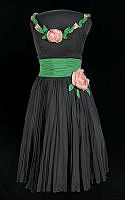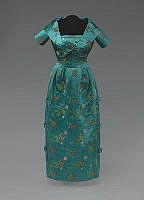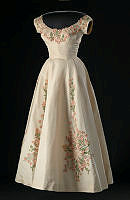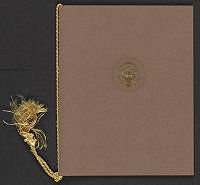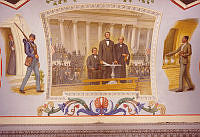Rubenstein Center Scholarship
Gracy Bradley's White House
This article is part of the Slavery in the President’s Neighborhood initiative. Explore the Timeline
On November 24, 1831, Andrew Jackson, Jr. married Sarah Yorke. President Andrew Jackson, a devoted father, wanted to give his son’s new bride a wedding present. In March of 1832, he purchased what he thought would be most helpful for a young woman setting up her own domestic household for the first time – an enslaved woman named Gracy Bradley.1

Excerpt from Andrew Jackson’s bank book for March 23, 1832, showing a check of $400 “to son for Negro Girl Grace”
Library of Congress, Manuscript DivisionGracy came to the Jacksons from the household of Colonel William Hebb of Washington, who had fallen so deeply into debt that he had to sell much of his property, including enslaved people. According to Mary C. Dorris’ 1915 account The Preservation of the Hermitage, Hebb was a “kind and considerate master” who gave his property “permission to select homes and purchasers for themselves” in order to avoid splitting up families.2 Born in Tennessee, Dorris was one of the founding members of the Ladies’ Hermitage Association, a private organization that acquired Andrew Jackson’s property from the state of Tennessee in 1889 in order to preserve it and promote the legacy of Andrew Jackson.3 Her narrative, written from the perspective of a white, Southern woman, comes with a heavy layer of pro-slavery bias; however it also provides some of the best information available about Gracy and the rest of her family.4 Click here to learn more about the enslaved households of President Andrew Jackson.
According to Dorris, one of Gracy’s sisters was a free woman employed as a pastry cook at the White House who asked President Jackson to purchase Gracy. Within the year, he had bought several members of the family – Gracy, her sisters Louisa and Rachel, and their mother Nancy Hebb.5 Some family members were sent directly to The Hermitage and remained there, but when Andrew Jackson, Jr., his wife Sarah, and soon two young children moved into the White House, Gracy and Louisa were assigned to work for them. Over the next several years, the two sisters were as much a White House family as any of the Jacksons.
We often think of the White House as a home, office, and stage for diplomacy, but it was also a place where enslaved people lived and worked. Many also faced the prospect of sale and family separation. Gracy, Louisa, and the rest of their family were not the only the enslaved people bought or sold by Andrew Jackson during his presidency. Although the actual sales did not take place on the White House Grounds, Jackson often made the arrangements and signed the checks from Washington.

Mary Dorris, one of the founders of the Ladies’ Hermitage Association
Andrew Jackson’s Hermitage, Nashville, TNLess than a month after President Jackson purchased Gracy, he acquired an eight-year-old girl named Emeline, who he gave to his grand-niece. His White House Secretary and nephew, Andrew Jackson Donelson, made the purchase on his behalf, but President Jackson reimbursed him for the girl.6 A child as young as Emeline should have been at home with her family, but instead she was sent to live and work in the home of a total stranger. Unless her family lived close by, she probably saw little of them after that. Other examples of active slave trading appear throughout President Jackson’s papers. In late 1831, he paid $420 for a “servant Boy” named Adam, writing the check directly this time instead of working through an agent or a relative.7 In 1830, he considered selling an enslaved woman named Charlotte and her three children for $800, claiming that she wanted to go and that her husband, Jackson’s carriage driver Charles, had agreed to be parted from her.8 This sale likely never took place, as Charlotte and her children appear in Hermitage records in the 1840s and 1850s. Still, the buying and selling of human property occurred frequently throughout his presidency.
Jackson’s activities did not go unnoticed, even in his own time. The abolitionist newspaper The Liberator accused him of “converting the President’s, or rather the People’s house, into a stall for the fattening of ‘human cattle!’”9 Nor was Jackson the only president to engage in such business from the White House. While he was running for president, James K. Polk claimed that he only bought enslaved men and women in order to reunite families or prevent separations. However, once in office he routinely bought enslaved children as young as ten to work on his plantation, without their parents. His wife’s brother, John Childress, arranged the purchases on his behalf in order to avoid damage to President Polk’s reputation.10 Click here to learn more about the enslaved households of President James K. Polk.

Excerpt from Andrew Jackson’s bank book for April 16, 1832, showing a check to his nephew Major A.J. Donelson for “a mulato girl, slave, bought by him for Andrew Jackson, which he has given to Mary Rachel, daughter of A. J. and Emily Donelson”
Library of Congress, Manuscript DivisionIn late 1834, Sarah Yorke Jackson came to live at the White House after a fire damaged The Hermitage mansion. She shared hostess duties and served as de facto First Lady for her father-in-law, President Andrew Jackson, along with Andrew Jackson Donelson’s wife, Emily, who had carried out that role for much of Jackson’s presidency.11 Sarah also had two young children – Rachel, born in 1832, and Andrew, born in 1834.12 As Mrs. Jackson managed a busy White House social calendar, Gracy and Louisa handled much of the daily domestic business of her household. Louisa served as a nurse for young Rachel and Andrew, while Gracy became a lady's maid to Sarah Jackson as well as a seamstress. Mary Dorris described Gracy’s skills as a seamstress as a “valuable acquisition” to the family in an era when making clothing by hand was a labor-intensive process, a description that reduces her to property value rather than personhood. She wrote that Gracy “relieved [Sarah Jackson] of most of the household cares, supervised the other servants, nursed the children, and was an expert seamstress,” all of which were essential to keeping the household running smoothly.13 Such intensive duties would have left Gracy little time to attend to her own needs or visit with her own family.

Sarah Yorke Jackson
White House Historical Association/White House CollectionBecause enslaved people had little access to education and rarely left any written account, we have no definitive record of how Gracy and Louisa felt about their White House experiences. We do know they were separated from their family during the eight years Jackson was president, spent long hours every day laboring for free, and enjoyed few holidays or breaks. Mary Dorris minimized these hardships in her account, claiming that Gracy, Louisa, and others purchased from the White House lived lives “full of beauty and interest.” Dorris insisted that Gracy’s skill as a seamstress earned her “not only the esteem but the affection of the family,” and that a “warm friendship” developed between her and Sarah Yorke Jackson.14 This account probably comes entirely from the Jackson family’s perspective, not Gracy’s. Such sanitized versions of the relationship between slave owner and slave were common in the late nineteenth and early twentieth centuries. Dorris cared more about bolstering Andrew Jackson’s legacy than she did about accurately conveying the experiences of enslaved people in the White House.
After Andrew Jackson’s presidency ended, Gracy and Louisa returned to The Hermitage with the Jackson family, where they reunited with their sister Rachel and their mother Nancy. All three daughters married members of The Hermitage’s enslaved community. During and after the Civil War, most of the enslaved workers left The Hermitage.15 Gracy Bradley and her husband Alfred Jackson chose to stay. By the 1880s, they were the only ones left living at the old plantation with the elderly Sarah Yorke Jackson.

The cabin where Gracy Bradley and Alfred Jackson lived at The Hermitage
Library of CongressDuring the late nineteenth century, Andrew Jackson’s popularity and legacy grew as the country looked for a pre-Civil War hero that both the North and South could celebrate. The Hermitage became a pilgrimage site for American tourists. In the last years of his life, Gracy’s husband Alfred took on the role of tour guide for the historic plantation, “escorting such pilgrims as may visit the historic spot and worship at the shrine of St. Andrew,” as one Chicago Tribune reporter put it.16 Catering to white tourists, Alfred’s tour centered on nostalgia for the “old slave times of long ago” and described General Jackson as the “embodiment of all human grandness and nobility of character.”17
Gracy and Alfred left no record of why they decided to remain at The Hermitage. Mary Dorris and other defenders of Jackson’s legacy claim that they stayed out of loyalty and love for the Jackson family. In contrast, General Roeliff Brinkerhoff, who lived at The Hermitage as a young man, described Alfred as “deeply discontent with his lot,” wishing to be free and to leave the estate.18 In the end, their decision to remain was probably driven by pragmatism. Job opportunities for freedmen were few and far between, especially for an aging, married couple unwilling to split up and unable to provide intensive field labor. Offering tourists the version of Jackson’s story that they wanted to hear gave Alfred and Gracy a greater degree of economic security and a place to live. Both remained at the estate until their deaths – Gracy in 1887 and Alfred in 1901.

Alfred Jackson
Andrew Jackson’s Hermitage, Nashville, TNThe story of Gracy Bradley and her family serves as a powerful reminder that enslaved labor within the White House walls was still connected to the broader system of slavery, including the brutality of the plantation. The majority of the early presidents were slave owners, and they often brought their enslaved workers to the White House as a means to save money on domestic staff. These staff shared familial and marriage ties with enslaved people at the presidents’ plantation homes, from whom they were often separated for years at a time. Some presidents bought and sold additional enslaved people during their time in office. And like many of the other great houses of the time, the White House required an extensive staff to function. The president’s salary was $25,000, and all expenses for the house, including wages for the servants, were expected to come out of that. It was not enough to maintain the house properly, so there was no realistic way an individual president could afford to keep up the house without either enslaved staff or extensive personal wealth. The legacy of that reliance on enslaved labor continues to impact the White House to this day.
Thank you to Dr. Daniel Feller, Director of The Papers of Andrew Jackson, and Marsha Mullin, VP Museum Services & Chief Curator at Andrew Jackson’s Hermitage, for their contributions to this article. To learn more about the papers of Andrew Jackson, please visit https://thepapersofandrewjackson.utk.edu/.


